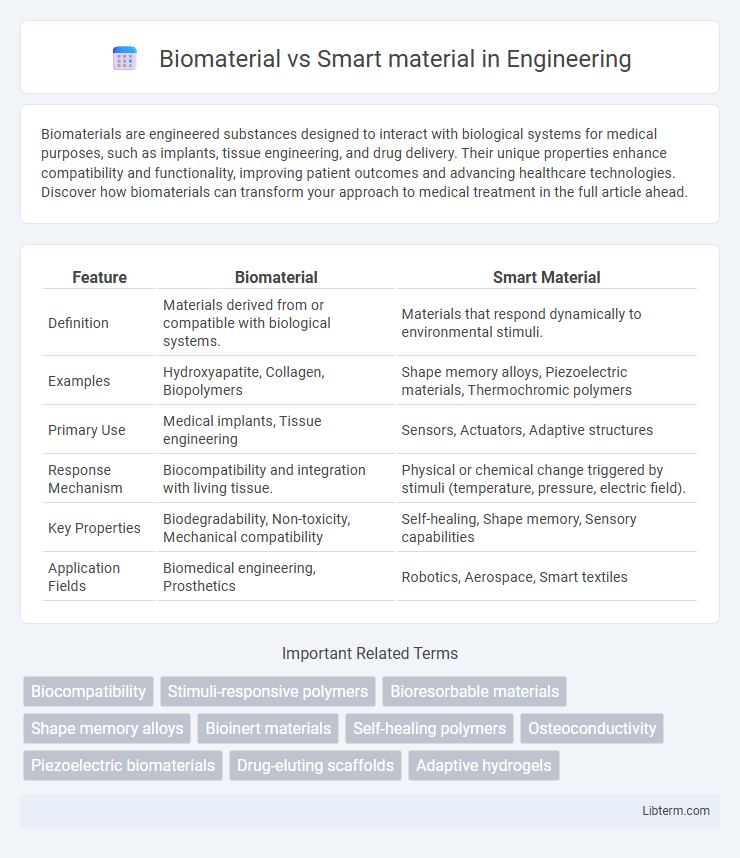Biomaterials are engineered substances designed to interact with biological systems for medical purposes, such as implants, tissue engineering, and drug delivery. Their unique properties enhance compatibility and functionality, improving patient outcomes and advancing healthcare technologies. Discover how biomaterials can transform your approach to medical treatment in the full article ahead.
Table of Comparison
| Feature | Biomaterial | Smart Material |
|---|---|---|
| Definition | Materials derived from or compatible with biological systems. | Materials that respond dynamically to environmental stimuli. |
| Examples | Hydroxyapatite, Collagen, Biopolymers | Shape memory alloys, Piezoelectric materials, Thermochromic polymers |
| Primary Use | Medical implants, Tissue engineering | Sensors, Actuators, Adaptive structures |
| Response Mechanism | Biocompatibility and integration with living tissue. | Physical or chemical change triggered by stimuli (temperature, pressure, electric field). |
| Key Properties | Biodegradability, Non-toxicity, Mechanical compatibility | Self-healing, Shape memory, Sensory capabilities |
| Application Fields | Biomedical engineering, Prosthetics | Robotics, Aerospace, Smart textiles |
Introduction to Biomaterials and Smart Materials
Biomaterials are natural or synthetic substances engineered to interact with biological systems for medical purposes, such as tissue engineering, implants, and drug delivery. Smart materials respond to environmental stimuli like temperature, pH, or stress by changing their properties, enabling applications in sensors, actuators, and adaptive systems. Understanding the fundamental properties and bio-compatibility of biomaterials alongside the responsiveness of smart materials drives innovation in biomedical engineering and advanced technology fields.
Defining Biomaterials: Properties and Applications
Biomaterials are substances engineered to interact with biological systems for medical purposes, possessing properties such as biocompatibility, biodegradability, and mechanical strength. These materials include polymers, ceramics, and metals used in applications like tissue engineering, drug delivery, and implantable devices. Smart materials differ by responding dynamically to environmental stimuli, but biomaterials primarily focus on safely integrating with living tissues to restore or enhance biological functions.
Smart Materials: Key Features and Innovations
Smart materials exhibit dynamic responses to environmental stimuli such as temperature, light, pH, and electric or magnetic fields, enabling adaptive functionality in real-time. Innovations in shape-memory alloys, piezoelectric materials, and self-healing polymers have expanded their applications in biomedical devices, robotics, and aerospace engineering. These materials combine sensing, actuation, and self-regulation capabilities to enhance system performance and longevity across various industries.
Fundamental Differences Between Biomaterials and Smart Materials
Biomaterials are primarily derived from natural or synthetic substances designed to interact with biological systems for medical purposes, such as implants or tissue engineering, emphasizing biocompatibility and biological function. Smart materials possess the ability to respond dynamically to external stimuli like temperature, pH, or electric fields, enabling adaptive changes in properties such as shape, color, or stiffness. The fundamental difference lies in biomaterials' focus on biological integration and compatibility, whereas smart materials prioritize responsiveness and functional adaptability to environmental changes.
Material Composition and Structural Characteristics
Biomaterials are primarily composed of organic and inorganic substances designed to interact with biological systems, often mimicking natural tissue composition such as collagen or hydroxyapatite. In contrast, smart materials incorporate responsive elements like shape-memory alloys, piezoelectric crystals, or stimuli-sensitive polymers that change their properties based on external triggers such as temperature, pH, or stress. Structural characteristics of biomaterials emphasize biocompatibility and bioactivity for integration with living tissues, while smart materials focus on adaptive functionality through engineered microstructures enabling reversible transformations.
Functional Mechanisms: Passive vs. Responsive Materials
Biomaterials function primarily through passive mechanisms, interacting with biological systems without altering their properties in response to environmental changes. In contrast, smart materials possess responsive functional mechanisms, enabling them to sense stimuli such as temperature, pH, or stress and adapt their behavior accordingly. This dynamic responsiveness allows smart materials to perform advanced tasks like self-healing, drug delivery, or shape transformation, distinguishing them from the static nature of traditional biomaterials.
Technological Advancements in Biomaterial Science
Technological advancements in biomaterial science have led to the development of bioengineered polymers and nanocomposites that promote tissue regeneration and enhance biocompatibility. These innovations enable precise control over material properties such as biodegradability, mechanical strength, and cellular interaction, surpassing traditional smart materials in biomedical applications. Cutting-edge techniques like 3D bioprinting and stimuli-responsive biomaterials are driving personalized and adaptive medical implants.
Emerging Applications of Smart Materials
Smart materials, unlike traditional biomaterials designed primarily for compatibility and structural support, possess dynamic properties that respond to environmental stimuli such as temperature, pH, or electric fields. Emerging applications of smart materials include self-healing coatings in aerospace, shape-memory alloys in minimally invasive surgical tools, and stimuli-responsive drug delivery systems that release medication precisely when needed. These advancements demonstrate the transformative potential of smart materials in enhancing functionality and adaptability across biomedicine, robotics, and wearable technology.
Challenges and Future Trends in Biomaterial and Smart Material Research
Challenges in biomaterial research include biocompatibility, long-term stability, and immune response mitigation, while smart materials face difficulties in integrating sensing capabilities and dynamic responsiveness within complex biological environments. Future trends emphasize the development of multifunctional biomaterials with enhanced regenerative properties and bioactive smart materials capable of real-time monitoring and adaptive behavior. Advances in nanotechnology, biofabrication, and machine learning-driven material design are expected to drive significant breakthroughs in both biomaterial and smart material research.
Comparative Analysis: Choosing the Right Material for Biomedical Applications
Biomaterials, derived from natural or synthetic origins, are primarily selected for their biocompatibility and ability to integrate seamlessly with biological tissues, making them ideal for implants and prosthetics. Smart materials, by contrast, possess adaptive properties such as shape memory, self-healing, or responsiveness to stimuli like temperature and pH, which enable dynamic interaction with the biomedical environment. Choosing between biomaterials and smart materials depends on specific application requirements, where static compatibility favors biomaterials, and multifunctional responsiveness demands smart materials for enhanced therapeutic outcomes.
Biomaterial Infographic

 libterm.com
libterm.com